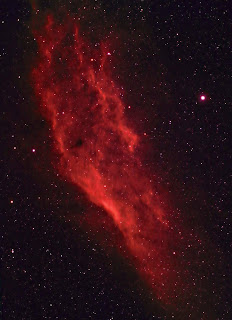I have already experienced this in my very limited time using PI. I stacked both the Ha and RGB data using PI and it produced two images which were aligned. I believe DSS can do this as well but I did not know it at the time so I spent few hours aligning the Ha and RGB images by hand and eye. I then combined these images using the NBRGB script function followed by a histogram stretch. Special thanks goes to Shannon Calvert for helping locate the NBRGB function. The combined image looked OK. PixInsight did in 10 minutes what me many hours to do in PS. I then exported the image to PS and did some of my favorite PS operations on this new rendition. Why didn't I just continue and process the whole image in PI? The point was to start using PI not totally switch yet and I wanted to get an image done quickly. It is going to be a long process in order to learn this program, I imagine over time I will use PS less.
The new image is sharper and show more nebulosity than the original image. Also, the stars as well as the star colors seem much more real or balanced, at least to me.
Reprocessed - PI and PS
Original - DSS and PS
Date: 11-28-17, 12-20-17
Camera: Canon EOS Rebel T3i(a), Backyard EOS
Telescope: Orion ED80 80mm f/7.5 Apochromatic Refractor Telescope
Barlow: None
Focal Length: 600mm
f/7.5
Focal Reducer: Orion 0.8x Focal Reducer for Refractor Telescopes
Mount: Orion Sirius EQ
Filter: Astrodon UV/IR, Astronomik Ha Clip-filter, UHC-clip
Autoguiding: QHY-5L-II-M attached to an Agena 50mm Guide Scope with Helical Focuser
Exposure: 29 x 120s, 60 x 120s
ISO: 1600
Temp: 8 C, -2 C
Post Processing: Original - Deep Sky Stacker, Photoshop, Astronomy Tools, Lightroom Reprocessed - PI and PS
https://kurtzeppetello.smugmug.com/


No comments:
Post a Comment